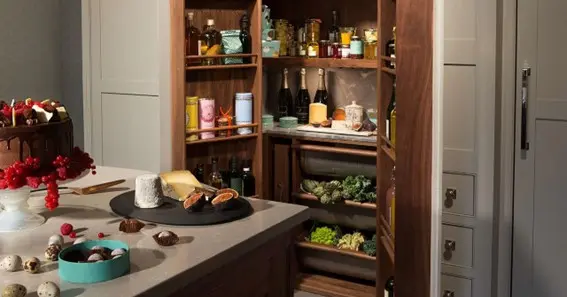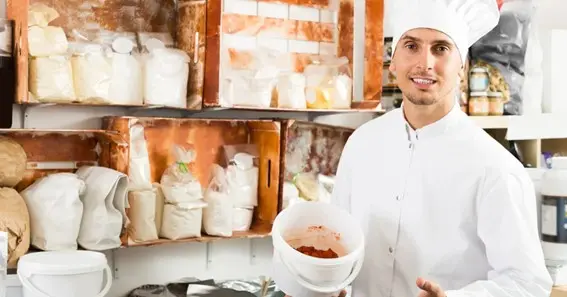What is a larder? Before modern cooling, a larder was a cool room or pantry storing meat, dairy, and preserves, which went bad quickly. Although it conjures up images of old kitchens and big farms, a larder is still relevant. Over time, larders have evolved from old-fashioned elegance to modern convenience, making them popular in many houses. A well-stocked pantry indicates good housekeeping and cooking preparedness, whether you live in a rustic farmhouse or a chic metropolitan flat. Let’s explore what is a larder, its fascinating history, operation, and function in modern households in this article.
What Is A Larder?
A Larder is essentially a pantry used to store food to keep it cool and fresh. Larders were crucial before refrigeration since they regulated perishables. They were usually on the north side of a house, where it was more relaxed, with thick walls and few windows. In Middle English, lardier or larder is a place to store fat or lard. Larders became essential to family life as they began to store more than just fats. This shot answer you have given you a basic understanding on what is a larder.
Also Read N: What Is 2D? Essential 2D Knowledge
Evolution Of Larders

After learning about what is a larder, let’s keep on learning about its history. Larders date to the middle Ages. The larder was crucial to large estates and castles. People stored salted meats, cheeses, and other foods there. The larder was frequently handled by a home worker who kept the preserved food supplies full. Over time, larders altered in appearance and function. Victorian English larders became finer. Marble slabs kept meals calm, and aluminum screens kept bugs out. The larders had distinct sections for dairy, meat, and dry products. This ensured optimal storage.
Also Read P: What Is A Thick Water? Science Behind Thick Water
Types Of Larders
Next after making what is a larder a bit clearer, let’s learn about its types each larder is ideal for storing something different. Walk-in, cabinet, and freestanding larders are most popular. Walk-in larders are more extensive and can store more food. Their size and food storage capacity make them ideal for large homes. However, cupboard larders fit into existing kitchen cupboards and are smaller. Small households benefit from them since they make it easy to reach frequently used items. Freestanding larders add space and versatility to the kitchen or closet.
Walk-In Larders
Food storage in walk-in larders is luxurious. These giant chambers house canned, dry, baked, and fresh food. Custom shelves, pull-out baskets, and food-specific spaces are popular in walk-in larders, which might include more complex temperature and humidity controls to keep food fresher.
Cupboard Larders
A cupboard larder is ideal if you want a pantry without a room. These larders are incorporated inside kitchen drawers for easy access and daily use. Food can be easily stored in cupboard larders with built-in drawers, pull-out shelves, and spice racks.
Benefits Of Having A Larder

A larder improves food storage and kitchen organization. Its ability to preserve food is a major benefit. A pantry keeps items calm and organized, preventing spoilage and space waste. Dairy, fruits, and vegetables go bad rapidly, which is helpful. A pantry simplifies finding and organizing. A food storage area makes it easier to keep track of what you have, reducing the chance of overbuying or forgetting.
Designing A Modern Larder
A modern larder that is both functional and attractive must combine aesthetics and utility. While planning a pantry, consider size, placement, and storage. Match the larger size to the amount of food you wish to store and the space in your home. A cabinet should be cold, dry, and free from direct sunlight and heat. Plan beforehand what food to store and how to organize it based on your family’s eating patterns and likes.
Shelving And Storage Solutions
A larder needs suitable shelving and storage to work. Adjustable shelves and pull-out baskets and bins make it easy to access stored items. Consider adding open shelves for often-used items, closed cabinets for rarely-used items, and areas for different types of food. Labels and clear cases keep the larder tidy and accessible.
Climate Control And Ventilation
Maintaining food freshness requires proper temperature and airflow. Good Larder airflow can prevent mold and humidity. Install air bricks or mesh-screened windows to ventilate the building. Food stays fresh longer if you spend more on climate control systems, which regulate temperature and humidity. This is crucial for larders with lots of perishable food.
Conclusion
Because of its old-fashioned elegance and modern convenience, a larder is an excellent addition to any home. For years, the Larder has been widespread. It began as a food storage unit in the middle ages and is now a fashionable and functional element of modern kitchens. Knowing what a larder is and how to install one for your home can improve your kitchen. Food storage is beneficial when you use a walk-in, cupboard, or freestanding pantry. A well-planned and organized pantry may become a beloved aspect of your home. This a brief article on what is a larder, to give you an understanding on this topic.
FAQ
What Is A Larder’s Function?
A larder was designed to keep perishable food cool and fresh. Different types of food can be kept in different rooms, closets, or separate facilities.
How Do Cupboards Vary From Pantries?
Larders keep food refrigerated and often have climate control, unlike pantries. Dry foods and non-perishables are stored in pantries.
Which Foods Should Be In A Larder?
A larder stores meats, fruits, vegetables, dairy, and cheeses in controlled conditions, keeping them fresher.
Can I Expand My Kitchen With A Larder?
A pantry is helpful in any kitchen, big or small. A cupboard larder or tiny standalone unit could fit in your space. Organizing and storing items efficiently maximizes a small pantry.
Why Is A Larder Useful?
A cupboard keeps food fresher, the kitchen is cleaner, and meal planning is easier. A well-planned pantry may also look and fit better in your home.
Sources:










